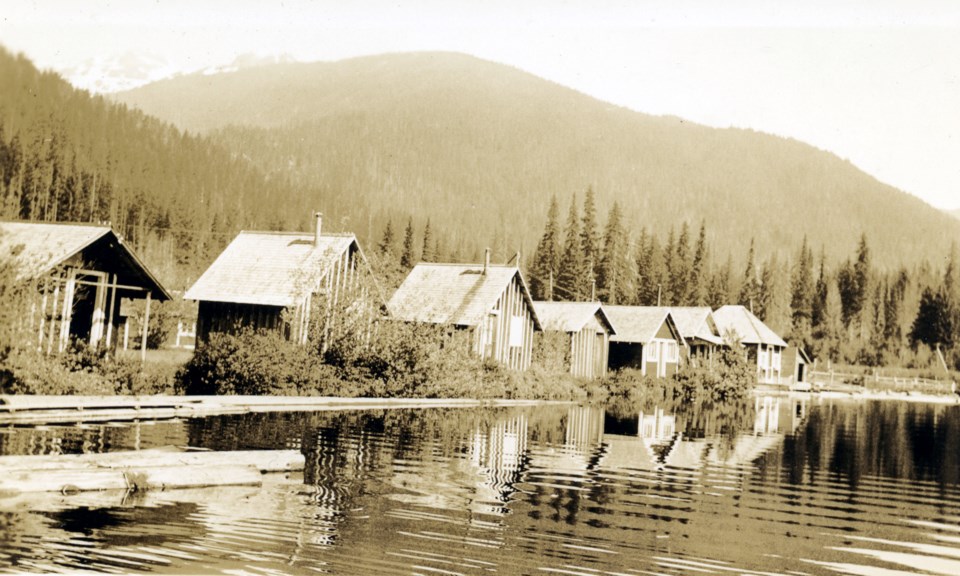When Whistler hit a road block in developing lake access in the late ’70s and early ’80s, the resort found the answers it was looking for at the end of the rainbow—Rainbow Lodge, that is.
The Whistler Question wrote in 1980, “the municipality has reviewed the opportunities in the Alta Lake area, and without expropriation or purchase of private land property, the recreational opportunity in the Alta Lake area for swimming, especially a beach area for young children, is extremely limited.”
It was clear all along that more public access was required for Alta Lake, and the Resort Municipality of Whistler (RMOW) was looking into buying lots on the foreshore of the lake to turn into parks. When Drew Meredith became mayor in 1986, the council of the day started to think bigger than buying single-family lots, and soon Rainbow Lodge caught their attention.
Rainbow Lodge, where Rainbow Park is now located, had a long history of tourism. Myrtle and Alex Philip opened the popular vacation destination for summer visitors in 1914. Then, in 1948, they sold Rainbow Lodge to the Greenwood family, where it continued as a summer resort. In its heyday, Rainbow Lodge contained more than 40 buildings, including a main lodge, post office, stables and many cabins.
Rainbow Lodge was sold to Joan Saxton, a speculator from Vancouver, in 1970. Resort operations at the lodge ceased in the early 1970s, however, people could still rent rooms and cabins on a more long-term basis. Disaster struck in 1977 when the main lodge burned down during renovations, and by 1986, many of the remaining buildings had fallen into disrepair.
While Whistler had gone through a period of booming development throughout the 1970s and 1980s, Rainbow Lodge remained rather unchanged.
“Pat Carleton said he wanted to get the town centre going, and then after that it would be my turn,” Saxton said during the expropriation in 1986. “They’ve down-zoned me and put me off the sewer system.”
In Saxton’s eyes, this unfairly reduced the value of the land, and the RMOW and Saxton could not come to an agreement on a purchase price.
The RMOW had the land appraised twice, and then went to the provincial government, where local officials received permission to expropriate the land for public interest. In 1987, the 43.2-hectare (108-acre) parcel of land on Alta Lake was expropriated for $367,000.
If the owners had been living on the property, the expropriation process may have been more difficult, but the Saxtons lived in the city and rented out some of the remaining cabins. Many of these buildings were in rough shape, and had to be demolished when the area became a park. Three of the cabins were preserved for historical value, however, and you can still see these in Rainbow Park today.
The park developed quickly, opening for public use during the summer of 1987. Early improvements to the property included creating a pedestrian crossing over the railway, building up the marshy pathway (which was often flooded), and clearing vegetation from the sandy beach. Open wells used for the lodge were filled in, the parking was cleared, and picnic tables were added. The beachfront and facilities continued to expand, and the park quickly reached the goal of becoming the top beach park in Whistler.
While the council at the time believed the deal was signed and done, the story of Rainbow Park does not end there. In what would become one of the longest lawsuits the RMOW has faced to date, the Saxton family continued to fight for further compensation. They argued that the land appraisals were not taking into account the size and development potential of the property.
In 2012, the decades-old dispute was finally settled, with the judge ordering the RMOW to pay an additional $2.4 million to the Saxton family, valuing the land at $12,000 an acre, comparable to the value of the Nicklaus North lands in the early 1990s. With hindsight, the land was revalued to $1.3 million dollars, and the RMOW was required to pay the difference, plus an additional $1.5 million for unpaid interest.
While Drew Meredith disagreed with the judgment, he said Rainbow Park was worth it even at $2.4 million. With the number of people enjoying the sunshine recently, I tend to agree.




